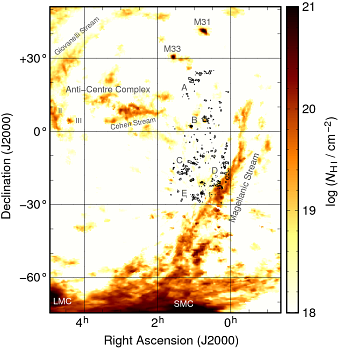Research
The Magellanic Stream
Introduction
Spanning over 100° across the sky, the Magellanic Stream is one of the most prominent H i structures in the vicinity of the Milky Way. It is believed to be the result of tidal interaction between the Magellanic Clouds and the Milky Way, but ram-pressure stripping may also have played an important role in forming and shaping the stream. The Magellanic Stream consists of two parts: a trailing stream, which is known as the original Magellanic Stream, and a leading stream, the so-called Leading Arm.
Magellanic Stream debris
 Using the H i Parkes All-Sky Survey (HIPASS) and its northern
extension, we have detected a population of 153 faint and compact H i
clouds which are probably associated with the Magellanic Stream. The clouds are scattered
over an area of almost 3% of the sky and out to about 20° from the main filament of
the stream. They appear to be arranged in several filaments which are almost parallel to
each other and the Magellanic Stream.
Using the H i Parkes All-Sky Survey (HIPASS) and its northern
extension, we have detected a population of 153 faint and compact H i
clouds which are probably associated with the Magellanic Stream. The clouds are scattered
over an area of almost 3% of the sky and out to about 20° from the main filament of
the stream. They appear to be arranged in several filaments which are almost parallel to
each other and the Magellanic Stream.
A possible association of these HVCs with the Magellanic Stream is also supported by their kinematics. All clouds have similar GSR velocities of the order of −200 km s−1 with a remarkably low dispersion of the entire population of only about 43 km s−1. The velocity of vGSR ≈ −200 km s−1 is consistent with that of the nearby Magellanic Stream, suggesting that the detected HVC filaments are forming a homogeneous population of clouds associated with the Magellanic Stream.
The detected HVCs are most likely just small neutral gas clumps within a much more extended and mainly ionised filamentary structure. This is supported by the detection of highly ionised O vi absorbers in this region by Sembach et al. (2003). The O vi is believed to trace the interface region between the warm neutral medium of the Magellanic Stream and the hot, ionised gas of the Galactic corona. Consequently, the Magellanic Stream could be much more extended than previously believed and surrounded by a complex and extended system of mainly ionised gas filaments reaching out to distances of up to 20° from the main stream. Detailed simulations of the Magellanic System will be necessary to understand the origin of these filaments, and any reliable simulation must succeed in reproducing the details of their complex structure.
Publications for further reading
- The scattered debris of the Magellanic Stream
Westmeier, T. & Koribalski, B. S. 2008, MNRAS, 388, L29
(astro-ph/0805.0820) - The scattered debris of the Magellanic Stream
Westmeier, T. & Koribalski, B. S. 2009, ATNF Annual Report 2007, p. 35
(Online version of the Annual Report 2007)